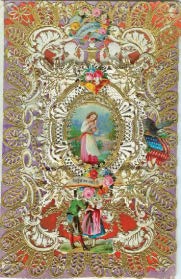ESTHER, THE LOVE MERCHANT

One woman is credited with popularizing paper lace valentines in the the United States. Esther Howland, whose family owned the largest book and stationery store in Worcester, Massachusetts, received an intricate English valentine from one of her father's business associates in 1847. Enamored with the idea, the 19-year-old convinced her father to order lace paper and embellishments from London and New York City and set to work making valentines. When her brother took her samples on his sales trip, he returned with more than $5,000 ($160,000 in today's dollars) worth of orders. Howland brought in her friends to build the valentines in an assembly-line style. "Esther Howland made valentines more readily available," says Rosin. "Her valentines had multiple layers of beautiful lace papers. The message would usually be deep inside."

6. THERE'S NO SUCH THING AS A BAD VALENTINE.
By the mid-1800s, technology was allowing the mass production of valentine cards. Hallmark's first card appeared in 1913. Expensive and time-consuming handmade paper confections were going out of fashion, and paramours no longer had an excuse for not showing their love.
Lesson: Be sure to give your valentine something—anything!
From the simplest of missives during the Great Depression to battleworn envelopes sent from overseas during World War II and other conflicts to classroom exchanges in the 1950s and '60s accompanied by little candy hearts, valentines have evolved into today's talking cards, e-cards, and video vows of devotion. Through it all, though, love has reigned supreme.
Lisa Hix is the senior editor of CollectorsWeekly.com.
DO YOU SAVE VALENTINES? Show us your favorites. Post pics at @theoldfarmersalmanac
Photos, from top: The Nancy Rosin Collection; Hallmark